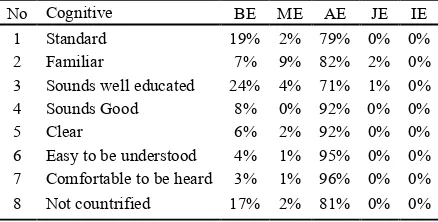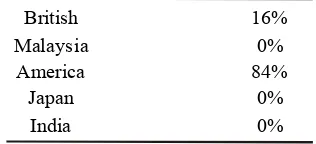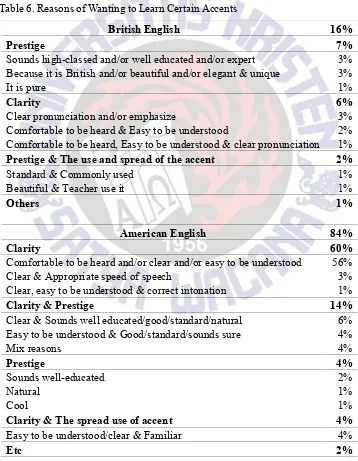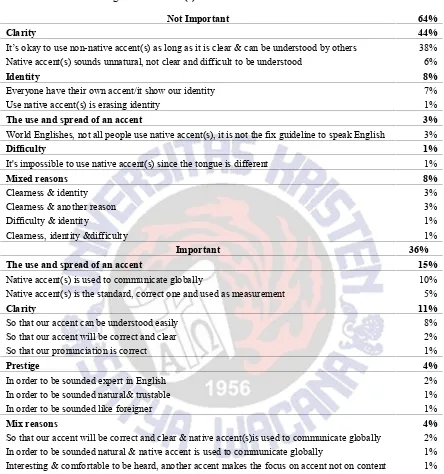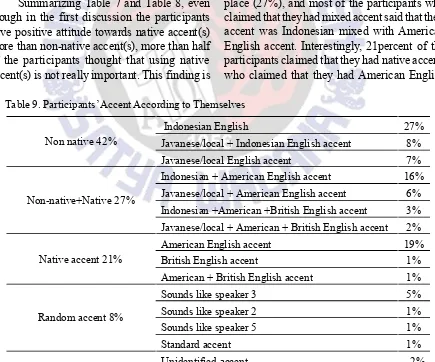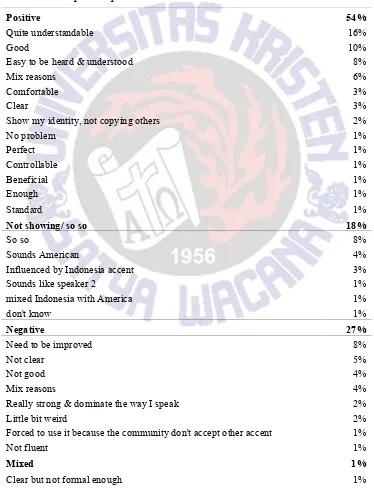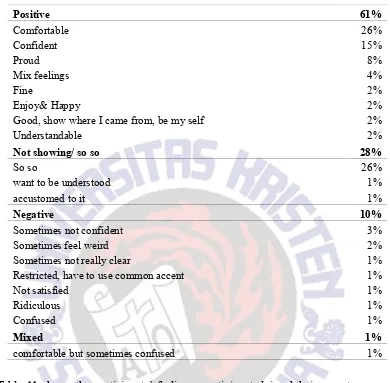INDONESIAN EFL STUDENTS ATTITUDES TOWARD VARIOUS ENGLISH ACCENTS AND THEIR OWN ACCENTS
Monika Dharma
Alumny Faculty of Language and Literature Satya Wacana Christian University
Salatiga
Christian Rudianto
Faculty of Language and Literature Satya Wacana Christian University
Salatiga
INTRODUCTION
Although monocentric view/native based English learning has been criticized and the World Englishes has been promoted, some English learners still hold the monocentric view because the education system makes them accustomed to do it. But not all countries share the same perspective. Learners from Japan, Korea and Chinese hold the monocentric view (Li, 2009; Jung, 2010; Mei 2011), whereas other countries such as South Africa, Pakistan, and India hold the English accent of their countries (Timmis, 2002). Thus, it provokes my curiosity about Indonesian students attitude toward various English accents.
REVIEW OF LITERATURE
native accent as the model and the goal of learning English (Jenkins, 2006). One of scholars who promotes such a monocentric view is Quirk (1985). He argues that teachers of English should focus on native norms as the model and the goal of learning English. Quirk (1990) states Standard English for written and spoken English is essential to control the use of English. If there is no Standard English to control, English might be divided into so many varieties which would result in its loosing the function of international communication.
However, monocentric view has a negative impact. It might undervalue other varieties of English. Learners will consider anything different from native accent is inferior. It might also result in discrimination. For example, if someone cannot speak like a native he/she cannot get a certain position/job (Farrell & Martin, 2009). Moreover, it is unrealistic and unachievable goal for non-native speakers to speak like native speakers. Non-native speakers cannot be native speakers unless they were reborn as native-speakers (Cook, 1999). Thus, responding to Quirk s monocentric view (1985, 1990) critics for monocentric view begins to rise. The first scholar who challenges the monocentric view is Kachru (1985) and recently the number of scholars who criticize monocentric view is rising (e.g. Jenkins, 2000, 2006; Kirkpatrick 2006, 2007; McKay, 2002). It has been argued that English should be World Englishes and should be based on pluricentric view. Pluricentric view appreciates varieties of English and promote that those varieties should be the base of learning depending on the context. One advantage of pluricentric view is this view enables learners and speakers of English to reflect his or her own sociolinguistic reality, rather than try to reach the distant native speaker s accent (Jenkins, 2006).
On the other hand, some studies show that English speakers and learners still hold a monocentric view in learning and speaking
English. There are some studies with Chinese and Korean students as the participants, and the result shows that most of them as the speakers of various accents still hold monocentric view. They preferred and were willing to imitate native accent(s) (e.g. Li, 2009; Jung, 2010; Mei 2011). In those studies most Asian students argue that their belief about English native accent is the best is because of the education system. They have to learn a certain variety in school that makes them accustomed to a particular variety. Those studies also show that native accent(s) gains positive attitudes. American English (AE) is clearer, more decisive, more professional (Li, 2009), popular, widely used, more middlebrow, more international, simple and easy to learn, rich in sound and pleasant to ears (Mei, 2011). While British English (BE) is the most standard and the origin of the English (Li, 2009), more authentic, truer, the birthplace, sounds elegant, soft in sound and has a touch of gentlemen and ladies (Mei 2011). In contrast, varieties accents gain negative attitudes and are considered as less prestigious, need to be corrected, ugly, and hard to be understood (Li 2009).
Interestingly while some research shows that the majority of Asian students as the speakers of various accents still hold the monocentric view, a research by Timmis (2002) in South Africa, Pakistan, and India shows that 64 percent participants hold the accent of their countries. Thus, it derives assumption that whether learners are willing to hold native accents or not is probably context-sensitive.
Definition of Attitude
evaluated can be concrete or abstract, individual or group, and is known as an attitude object. Fleming (1967) points out that cognitive component is generally attributes and beliefs about the attitude object, while affective component is emotions and feelings associated with the object.
Attitude is the way a person does an evaluation and gives reaction toward an object (whether the object is thing/things, person or group, and something abstract or concert). And this reaction is influenced by the person s cognitive (thought, belief and idea) affective (feeling/emotion) and behavioral (a certain way of act) toward that thing. And the result of this reaction (whether it is obvious/ unobvious) is the person cognitive, affective, or behavioral toward something.
Standard English
Standard English in this study is defined based on three prominent scholars definition of Standard English. The first scholar is McArthur (2003). He argues that Standard English is, in general, the variety that is commonly received, understood, and maybe valued in an English speaking country, and it has a minimum of three known characteristics which are easiest to recognize in print because written conventions are similar worldwide, usually used by news presenters, and relates to the speaker s social class and education. The other scholar is Farrell & Martin (2009), they argue that Standard English implies that all English users and learners have the same understanding of what it means. The last scholar is Trudgill (2011), who defines standard English as the most important variety of English that has characteristics, such as usually used in writing especially for printing, used in the education system in all the English-speaking countries of the world also be taught to non-native learner, and used by those who are often referred to as educated people, but it has nothing to do with pronunciation, it is not an
accent or a style and a register. Standard English is a sub-variety of English, which usually Sub-varieties of languages are referred as dialects.
However the issue of Standard English is not simple. As Seidlhofer (2005) points out, there is considerable confusion and disagreement about what Standard English actually is. The issues of Standard English become complicated because of four reasons. The first and second reason comes from Farrell & Martin (2009). First, there is no world-recognize governing body writes what supposed to be and not supposed to be included in such as a standard, therefore there is no fix agreement of description or characterization of Standard English. Second, there is a general assumption that Standard English should be used for teaching non-native learners, but, in fact, there is no agreement of what student of ESL or EFL need or want to learn. The third reason is because the answer of which variety is Standard English? is changing from time to time. As McArthur (2001) mentions, in 1900 the answer was Queen s and King s English variety, which is British. But by the 1930s, after the Second World War the answer changed and became both of British and American Standard English. However, by the closing decade of the 20th century, because of the increasing English users, the variety which was claimed standard began to rase. Take for example Australia, Canada, and the Philippines Standard English.
The presence of complexity and no fix agreement of Standard English is one of the strong supports to challenge the monocentric view. If the Standard English itself is not fixed why should teachers teach it to learners.
World Englishes
new Englishes in Africa, Asia, and the Caribbean (Kachru s outer circle). Third, it is used to represent the pluricentric view to the study of English associated with Kachru and his colleagues, and is often referred to as the Kachruvian approach. In other words, World Englishes value the varieties of English and promote pluricentric view for teaching and learning English. According to Mei (2011) WEs raises Intelligibility Principle where speakers of English varieties, even with a strong accent, can communicate well. Bian (2009) argues that the assessment of intelligibility principle is how well a speaker can make people understand him/her. Based on the discussion above, this study attempts to answer the following questions: 1. What are Indonesian EFL attitudes toward
various accents? With sub questions: What are Indonesian EFL Students Cognitive, affective and, behavioral attitudes toward various English accents?
2. What are their opinions about the importance of using native accent(s)?
3. What are their opinions about their own accent?
This study aims at analyzing Indonesian EFL students attitudes toward various accents. Attitudes here consist of cognitive, affective and behavioral components (Eagly & Chaiken, 1993). I believe this study will be significant to provide a contextual study in relation to Indonesian students attitude toward various English accent(s).
THE STUDY Method of the Study
This study used a quantitative method by counting the percentage of each emerging theme of each question.
Contexts of the Study
The setting of the study was in English Department Satya Wacana Christian University
(SWCU) in Salatiga, Central Java, Indonesia. English with various accents do exist in this place, so the participants were assumed to have some ideas of various English accents.
Participants
The participants were 100 English Department students which were chosen based on Purposive sampling or criterion-based selection (Blackledge, 2001, p.57) anda Sample of Convenience(McKay, 2006, p.37). According to Zacharias (2011) Purposive sampling is selecting participants based on purpose, means that the participants that are chosen because they can meet certain criteria. For this study the purposive sampling was used for deciding English Department students as the participant because they were accustomed to listen and speak English almost every day, so they were aware of the use of spoken English and they were accustomed to listen to various accents by their friends and teachers, so they had the background knowledge of various accents. While for convenience sampling, Zacharias (2011) states that convenience sampling is selecting participants because the participants are easily accessible. In this study convenience sampling was used for deciding the individual participants.
Instrument of Data Collection and Procedure
to each other and easily distinguished. In the questionnaire the accents were not named by its country, rather those were named as speaker 1 until 5. Thus the participants would not judge the accents only by the country where those came from. The open ended had a purpose to let participants elaborate their opinion about the importance of using native accent and opinion about their own accent. The questionnaire used Bahasa Indonesia and had three main part of discussion, which were: participants attitudes towards the various accents, participants opinions about the important of using native accent, and participants opinions about their own accent.
The questionnaire was filled out while the participants listen to the recording. The recording was picked from www.dialectsarchive.com, and the recording contained a short story titled
Commas gets a cure and was read 5 times with BE (named speaker 1 in the recording), ME (speaker 2), AE (speaker 3), JE (speaker 4), and IE accent (speaker 5).
The percentage of the return rate of the questionnaire was 100 percent because the researcher waited every individual participant to fill out the questionnaire. The data was gathered for about 2 months.
Data Analysis
The data analysis was done by counting the percentage of each part of the questionnaire. The attitude towards various English accents (cognitive, affective, and behavioral attitudes) was counted first to see which variety got the most positive to the least positive attitudes. Then, the desire of learning certain accent was also calculated. The reasons for the importance of learning that certain accent were counted from the categorization of their answers from the open-ended questionnaire.
Participants opinion towards their own accent and the reasons for using their own accents were also counted in the same way. At
the end of the analysis, the possibility why the results appeared such a way and the possible situation affecting the results were discussed using the existing theories and previous studies worldwide. Conclusion was finally drawn based on the analysis and discussion.
FINDINGS AND DISCUSSION
The data findings are discussed in three parts of discussions, namely Indonesian EFL Students cognitive, affective and, behavioral attitudes toward various English accents; opinions about the importance of using native accent(s), whether using native accent(s) is important or not, and reasons of their opinions; opinions about their own accent, what accent they perceive they are using, and their feelings when they use their accent.
Indonesian EFL Students Cognitive, Affective and, Behavioral Attitude toward Various English Accents
Cognitive attitude
There are 8 positive cognitive sub-themes toward various English accents in this study: standard, familiar, sounds well educated, sounds good, clear, easy to be understood, comfortable to be heard, not countrified. There are also 8 negative cognitive sub-themes: not standard, weird, sounds not well educated, sounds not good, not clear, hard to be understood, not comfortable to be heard, countrified.
No Cognitive BE ME AE JE IE
1 Standard 19% 2% 79% 0% 0%
2 Familiar 7% 9% 82% 2% 0%
3 Sounds well educated 24% 4% 71% 1% 0% 4 Sounds Good 8% 0% 92% 0% 0%
5 Clear 6% 2% 92% 0% 0%
6 Easy to be understood 4% 1% 95% 0% 0% 7 Comfortable to be heard 3% 1% 96% 0% 0% 8 Not countrified 17% 2% 81% 0% 0%
Table 1. Positive Cognitive Attitudes
cognitive attitudes, and the gap percentage between native(s) and non-native accent(s) was quite much. Standard accent was the highest positive cognitive attitude. 98 percent (AE 79%+ BE 19%) participants thought that the standard one is native accent(s). Just 2 percent (ME 2%) of participants claimed non-native accent(s) is standard. These findings confirm Farrell & Martin s (2009) opinion that Standard English is often associated with American and British Standard English. Native accent(s) was considered familiar by 89 percent (AE 82%+BE 7%), while for non-native accent(s) was 11 percent (ME 9%+JE 2%). It is quite interesting that in terms of familiar accent ME is on the second place and defeats BE. Whether certain accent Sounds well educated , 95 percent (AE 71%+BE 24%) participants stated that native accent(s) sounds well educated. Only 5 percent (ME 4%+JE 1%) stated that non-native accent(s) sounds well-educated. The possible reason why AE and BE are considered to sounds well educated is because in Indonesian Education system, these two major English accents that are used for spoken is AE and BE (Siregar, 2010). The fourth positive cognitive attitude is sounds good accent . None of the participant stated non-native accent(s) is good, the entire participants (AE 92% + BE 8%) stated that native accent(s) sounds good. Moving to clarity , native accent(s) was declared as clear by 99 percent (AE 92% + BE6%), while non-native accent(s) (only NE) was said to be clear only by 1 percent. For the sub-theme easy to be understood , 99 percent (AE 95% + BE 4%) participants stated that native accent(s) was easy to be understood. Only 1 percent of participants stated that non native-accent(s), ME, was easy to be understood. 99 percent of participants stated that AE and BE (AE 96% + BE 3%) were comfortable to be heard. Only 1percent of participants stated that non-native accent, ME, was comfortable to be heard. Lastly, for accents that were not countrified , the participants who thought that
native accent(s) was not countrified was 98 percent (AE 81% + BE 17%), while non-native accent(s) were considered as countrified by 2 percent of participants.
No Cognitive BE ME AE JE IE
1 Not standard 8% 17% 1% 27% 47%
2 Weird 9% 16% 0% 36% 39%
3 Sounds not well educated 4% 16% 0% 18% 62% 4 Sounds not good 7% 22% 0% 37% 34%
5 Not clear 13% 13% 0% 41% 33%
6 Hard to be understood 18% 14% 0% 27% 41% 7 Not comfortable to be heard 10% 20% 0% 35% 35%
8 Countrified 3% 15% 0% 27% 55%
Table 2. Negative Cognitive Attitudes
perception of hard to be understood , 82 percent (IE 41%+JE27%+ME 14%) participants claimed that non-native accent(s) was hard to be understood, and 18 percent of participants claimed that BE was hard to be understood. Moreover, 90 percent (IE 35%+ JE 35% +ME 20%) of participants claimed that non-native accents were not comfortable to be heard, while only 10 percent mentioned that so was BE. Finally, 97 percent (IE 55%+ JE 27% +ME 15%) participants states non-native accent(s) was countrified, and 3 percent (BE 3%) participants states native accent was also countrified. Table 2 also shows that unlike AE which only gained 1 percent for being not standard accent , BE gained more negatives cognitive attitudes. Affective attitude
In this study the positive affective attitude toward various English accents refers to like the accent of , while the negative affective refers to don t like the accent of.
Table 3. Affective Attitude towards Various Accents
Like Don't like
British 15% 12%
Malaysia 1% 9%
America 83% 0%
Japan 0% 32%
India 1% 47%
Table 3, shows that the participants liked AE (83%), followed by BE (15%). This means that almost all participants (99%) felt that they were in favor of native accent(s). On the other hand, IE was the least favored accent (47%), followed by JE (32%), BE (12%), and then ME (9%). It means the majority of participants (88%) felt that they did not like non-native accent(s). However, it is interesting that the number of participants who do not like BE accent is greater than those who like ME accent.
Behavioral attitude
Willingness to use and learn certain accent to speak indicates positive behavioral attitude in this study. The participants willingness is shown in the table 1.C.1.
Table 4 shows that to speak with Indonesian fellows the participants said that they would use AE (89%), followed by BE & ME (5%). It means that most of the participants (94%) were willing to use native accent(s) to speak to Indonesian fellows. Only 6 percent of the participants (ME 5%+IE1%) were willing to use-non native accent(s) to speak with Indonesian fellows. Meanwhile, to speak with foreigner on the first place the participants chose to use AE (90%), followed by BE (6%). This means that the majority of participants (96%) were willing to use native accent(s) to speak with foreigner. Very few participants (4%) were willing to use non-native accent(s), which was ME, to speak to foreigner.
The desire to use certain accent leads to eagerness of learning that particular accent. The participants wants to learn accents and the reasons are presented in Table 5 and Table 6.
Table 5. The Desire to Learn Various Accents
British 16%
Malaysia 0%
America 84%
Japan 0%
India 0%
Table 6 shows that the 84 percent of participants wanted to learn American accent and 16 percent British accent. This means that all participants (100%) wanted to learn native accent(s). This finding is similar with Siregar s
No Behavioral attitude BE ME AE JE IE 1 Will use to speak to Indonesian
fellows 5% 5% 89% 0% 1%
2 Will use to speak to foreigners 6% 4% 90% 0% 0%
study (2010) that Indonesian EFL students in Maranatha Christian University Bandung had no concern to learn new varieties of English. They were only interested in learning AE and BE that are considered the standardized English.
Table 6 explains the reasons why the participants wanted to learn American and British accents. The highest reason for learning BE accent was prestige (7% out of 16%). The second reason was because of clearness (6% out
of 16%). The next reason was between prestige and the use and the spread of English (2% out of 16%), and 1 percent had other reasons (1% out of 16%). On the other hand, the reason for wanting to learn AE accent was because of clearness (60% out of 84%), followed by the clearness (14% out of 84%), prestige (4% out of 84%), the mix of clearness and the use & spread of English (4% out of 84%), and other reasons (2% out of 84%).
Table 6. Reasons of Wanting to Learn Certain Accents
British English 16%
Prestige 7%
Sounds high-classed and/or well educated and/or expert 3% Because it is British and/or beautiful and/or elegant & unique 3%
It is pure 1%
Clarity 6%
Clear pronunciation and/or emphasize 3%
Comfortable to be heard & Easy to be understood 2% Comfortable to be heard, Easy to be understood & clear pronunciation 1% Prestige & The use and spread of the accent 2%
Standard & Commonly used 1%
Beautiful & Teacher use it 1%
Others 1%
American English 84%
Clarity 60%
Comfortable to be heard and/or clear and/or easy to be understood 56%
Clear & Appropriate speed of speech 3%
Clear, easy to be understood & correct intonation 1%
Clarity & Prestige 14%
Clear & Sounds well educated/good/standard/natural 6% Easy to be understood & Good/standard/sounds sure 4%
Mix reasons 4%
Prestige 4%
Sounds well-educated 2%
Natural 1%
Cool 1%
Clarity & The spread use of accent 4%
Easy to be understood/clear & Familiar 4%
Table 1 until Table 6 show a condition why the native accent, especially AE, is always on the first place to have positive attitudes and has very little attribute negative attitudes. The same finding is also found in Siregar s study (2010) that her participants had the most positive attitudes to AE in almost all aspects. On the other hand, BE was almost always at the second place for getting positive attitudes, although it gained much more negative attitudes than AE. The possible reason of such a condition is because BE is not commonly used in Indonesia. One of the participant stated, People around me don t seem to accept people trying to speak in British accent. I have to use common accent, British is uncommon. In Indonesia, exposures toward AE is more than BE. The examples of exposure toward AE are through TV shows, movies and songs. Maridjono s study (2003) toward Indonesian EFL students in English Department of Petra Christian University, Surabaya, revealed that most of the participants experienced watching undubbed TV shows and movies as the exposure to English. Most of the TV shows were originated from the United States and use AE accent.
Among the three non-native accents, ME received the most positive attitudes and the least for negative attitudes. Table 1even shows that the participants considered Malaysian accent was at the second place in terms of familiarity, defeating British accent. Moreover, for negative affective behavior don t like and behavioral will not use to speak with Indonesian , ME gained less percentage than BE accent. Such a condition may occur because Malaysia is located near Indonesia. So, the accent is quite similar with Indonesian accent. According to Siregar (2010), Malay language is similar with Indonesian, thus ME is considered as the easiest accent to learn. Meanwhile, JE gained very little positive attitudes, and almost always on the second place for getting negative attitudes. At the very bottom, IE received very little positive attitudes and gained the most negative attitudes.
To summarize, Table 1 until Table 6 show that native accents (American and British) received positive attitudes more than non-native accents (Malaysia, Japan, India). The positive attitudes given to native accent were always above 80 percent. On the other hand, non-native accents received more negative attitudes, and the negative attitudes given to non native accents were almost always above 80 percent. This result is similar with Li s (2009) and Mei s study (2011) which stated that the most positive attitudes were given to native accents. AE was clearer, more decisive, more professional (Li, 2009), popular, widely used, more middlebrow, more international, simple and easy to learn, rich in sound and pleasant to ears (Mei, 2011). While BE was considered as the most standard and the origin of the English (Li, 2009), more authentic, truer, the birthplace, sounds elegant, soft in sound and has a touch of gentlemen and ladies (Mei 2011). In contrast, various accents gained negative attitudes and considered as less prestigious, not standard, weird, and hard to be understood (Li 2009).
Indonesian EFL Students Opinions About the Importance of Using Native Accent(s)
In the first discussion the participants had more positives attitude towards native accents. The next question is whether the positive attitude automatically means that the participants think that using native accent(s) is really important. The next session explores the participants opinion about the importance of using native accent(s).
Table 7. Using Native Accent(s) is Important
NO 64%
Table 7 shows the importance of using native and non-native accents with the participants perceived importantce. 64 percent participants thought that using native accent(s) is not important and 36 percent thought it was important. Table 8 explains the reasons of such condition. The main reason why the participants thought using native(s) accent is not important
is because they thought that clarity is the most important reason in using English. As long as their accent was clear and could be understood by others it was okay to use non-native accent, moreover, using native accent(s) sounded unnatural for non-English speakers & difficult to be understood. This condition shows that the participants hold intelligibility principle. Identity Table 8. Reasons for Using Native Accent(s)
Not Important 64%
Clarity 44%
It s okay to use non-native accent(s) as long as it is clear & can be understood by others 38% Native accent(s) sounds unnatural, not clear and difficult to be understood 6%
Identity 8%
Everyone have their own accent/it show our identity 7%
Use native accent(s) is erasing identity 1%
The use and spread of an accent 3%
World Englishes, not all people use native accent(s), it is not the fix guideline to speak English 3%
Difficulty 1%
It's impossible to use native accent(s) since the tongue is different 1%
Mixed reasons 8%
Clearness & identity 3%
Clearness & another reason 3%
Difficulty & identity 1%
Clearness, identity &difficulty 1%
Important 36%
The use and spread of an accent 15%
Native accent(s) is used to communicate globally 10%
Native accent(s) is the standard, correct one and used as measurement 5%
Clarity 11%
So that our accent can be understood easily 8%
So that our accent will be correct and clear 2%
So that our pronunciation is correct 1%
Prestige 4%
In order to be sounded expert in English 2%
In order to be sounded natural& trustable 1%
In order to be sounded like foreigner 1%
Mix reasons 4%
So that our accent will be correct and clear & native accent(s)is used to communicate globally 2% In order to be sounded natural & native accent is used to communicate globally 1% Interesting & comfortable to be heard, another accent makes the focus on accent not on content 1%
was the second reason. The participants stated that everyone has their own accent which shows identity, and using native accent was considered erasing identity. The other reason was the use and spread of an accent, difficulty, and combinations of two or more reasons.
On the other hand, the reasons why the participants think using native accent(s) is important is because the widely use and the spread of an accent. The participants think native accent(s) is used to communicate globally, and it is the standard, correct one and used as measurement. The second reason is standard articulation. The participants think if they are using native accent(s) their accent will correct and clear. The next reason is prestige. The participants use native accent(s) in order to sound expert in English, natural and trustable.
Summarizing Table 7 and Table 8, even though in the first discussion the participants have positive attitude towards native accent(s) more than non-native accent(s), more than half of the participants thought that using native accent(s) is not really important. This finding is
Table 9. Participants Accent According to Themselves
Non native 42% Javanese/local + Indonesian English accentIndonesian English 27%8%
Javanese/local English accent 7%
Non-native+Native 27%
Indonesian + American English accent 16% Javanese/local + American English accent 6% Indonesian +American +British English accent 3% Javanese/local + American + British English accent 2%
Native accent 21% American English accentBritish English accent 19%1% American + British English accent 1%
Random accent 8%
Sounds like speaker 3 5%
Sounds like speaker 2 1%
Sounds like speaker 5 1%
Standard accent 1%
Unidentified accent 2%
similar with Li s (2009) finding which shows that more than half participants did not bother with non-native accents as long as they understood what the speakers meant.
Indonesian EFL Students Opinions About Their Own Accent
This part of discussion has 3 sub topics which are participants accent according to themselves, opinion about their accent, and feeling when they use their accent.
accent. Random accent was on the fourth place (8%), and on the last place was unidentified accent (2%).
Table 10 shows that the participants who had positive opinions about their own accent were slightly more than half of the participants (54%). Some positive opinions stated by the participants were because their accent was quite understandable, good, easy to be heard and
understood. The percentage of Participant s negative opinions about their accent was half the positive opinions (27%). Some negative opinions mostly stated by the participants were the need of improvement, not clear, and not good. However, 18 percent of the participants did not really have negative or positive opinion about their accent, and only one participant had a mixed of positive and negative opinion.
Positive 54%
Quite understandable 16%
Good 10%
Easy to be heard & understood 8%
Mix reasons 6%
Comfortable 3%
Clear 3%
Show my identity, not copying others 2%
No problem 1%
Perfect 1%
Controllable 1%
Beneficial 1%
Enough 1%
Standard 1%
Not showing/ so so 18%
So so 8%
Sounds American 4%
Influenced by Indonesia accent 3%
Sounds like speaker 2 1%
mixed Indonesia with America 1%
don't know 1%
Negative 27%
Need to be improved 8%
Not clear 5%
Not good 4%
Mix reasons 4%
Really strong & dominate the way I speak 2%
Little bit weird 2%
Forced to use it because the community don't accept other accent 1%
Not fluent 1%
Mixed 1%
Clear but not formal enough 1%
Positive 61%
Comfortable 26%
Confident 15%
Proud 8%
Mix feelings 4%
Fine 2%
Enjoy& Happy 2%
Good, show where I came from, be my self 2%
Understandable 2%
Not showing/ so so 28%
So so 26%
want to be understood 1%
accustomed to it 1%
Negative 10%
Sometimes not confident 3%
Sometimes feel weird 2%
Sometimes not really clear 1%
Restricted, have to use common accent 1%
Not satisfied 1%
Ridiculous 1%
Confused 1%
Mixed 1%
comfortable but sometimes confused 1%
Table 11. Feeling when using own accent
Table 11 shows the participants feeling when they use their accent. 61 percent of the participants felt comfortable, confident, and proud of using their accent. A few participants (28%) were not sure about their feelings, whether they feel positive or negative feelings. However, 10 percent of participants sometimes felt unconfident, and felt weird about their own accent.
The findings from Table 9, Table 10 and Table 11 are in contrast with Mei s (2011) finding which shows that more than half of her participants believed that their English had a flavor of AE, and they were not very confident when speaking English with Chinese accent, because they feared that other might not understand their English. In this study, the
participant claimed their accent was non-native accent and they had positive opinions about their accent and positive feeling when they use their accent although their attitude towards native accent(s) was very positive.
CONCLUSION
using native accent(s) was not important because they thought that the most important in communication was intelligibility. As long as their accent was clear & can be understood by others it was okay to use non-native accent(s). In addition, most of participants claimed that their accent was non native-accent.They claimed that their accent was Indonesian English. Moreover, they had positive opinions about their accent and had positive feelings when they used their accent.
From this research s findings I found two interesting points. First, even though positive attitudes are given to native accents, when native accents and non-native accents are compared, actually Indonesian EFL students attitudes toward non-native accents is not totally bad because most of the participant think that using native accent is not a must. They also claimed that their accent was non native-accent, but they have positive opinion toward their accent also positive feeling when using it. There is a possibility that negative attitudes are given to non-native accents which come from other countries that have quite different accent from Indonesian English accent. It is strengthen by the finding that ME, as non-native accent, receives the most positive attitudes and the least for negative attitudes. The participants even think ME is at the second place for its familiarity to be heard defeating BE. For Indonesian EFL students, although British accent belongs to native accent, attitude toward British accent is not as good as American accent. The gap number of positive attitude between American and British accents is quite high.
Recently the number of non-native speakers of English is much more than the number of native-speakers. Hence, the possibility to engage in English communication with non-native speakers than with non-native is greater. Although this research implies that most of participants basically believe in intelligibility principles, they still have negative attitude
toward English accent which come from countries that have quite different accent from Indonesian English accent. There is a possibility that they will find difficulties in understanding a certain non-native accent that is too far different from Indonesian English accent. Therefore, the exposure of non-native English accent should be improved to make the participants familiar with various accents, decrease negative attitudes toward various accents, and focus more on understanding the meaning of communication. In addition, this research might result in different finding if it was implemented to different context of the study (for example in Bali, where exposure toward various accent is quite much), different participants (for example participant who have experience of studying abroad), and different various accents. Further research could be conducted in those contexts.
REFERENCES
Crystal, D. (2003).English as a global language. Cambridge: Cambridge University Press. Eagly, A.H., & Chaiken, S. (2007). The advantages of an inclusive definition of attitude.Social Cognition,25(5), 582-602.
Farrell, T. S. C. & Martin, S. (2009). To Teach Standard English or World Englishes? A Balanced Approach to Instruction. English teaching forum 2009 (2).
Jenkins, J. (2006). Current perspectives on teaching World Englishes and English as a lingua franca.TESOL Quarterly, 40 (1), 157-181.
Jung, M-Y. (2010). The Intelligibility and Comprehensibility of World Englishes to Non-Native Speakers. Journal of Pan-Pacific Association of Applied Linguistics, 14(2), 141-163.
Li, C. S. D. (2009). Researching non-native speakers views toward intelligibility and identity: Bridging the gap between moral high grounds and down-to-earth concerns. In F. Sharifian (Ed.), English as an International Language: Perspectives and Pedagogical Issues. UK: Multilingual Matters.
Maridjono, J. J. (2003). English Accent Evaluation: A Study on Indonesian EFL
Learners Perception.Kata, Vol, 5. No. 2,
147-164.
McArthur, A. (2001). World English and World Englishes: Trends, tensions, varieties, and
standards.Language Teaching, 34, 1 20.
Mei, W. (2011) An Investigation of Freshman English Majors Attitudes Towards English
With an Accent. US-China Foreign
Language, Vol. 9, No. 11, 714-720.
Miller, M.G., & Tesser, A. (1990). Attitudes and Behavior:The Cognitive-Affective Mismatch
Hypothesis.Consumer Research 17
(pp.86-90).
Siregar, F. L. (2010). The Language Attitudes of Students of English Literature and D3 English at Maranatha Christian University toward American English, British English and Englishes in Southeast Asia, and their various contexts of use in Indonesia.
Philippine ESL Journal, Vol. 4, February 2010.
Trudgill, P. (2011). Standard English: what it
isn t. University of Agder.
Zacharias, T. N. (2011). Qualitative Research
